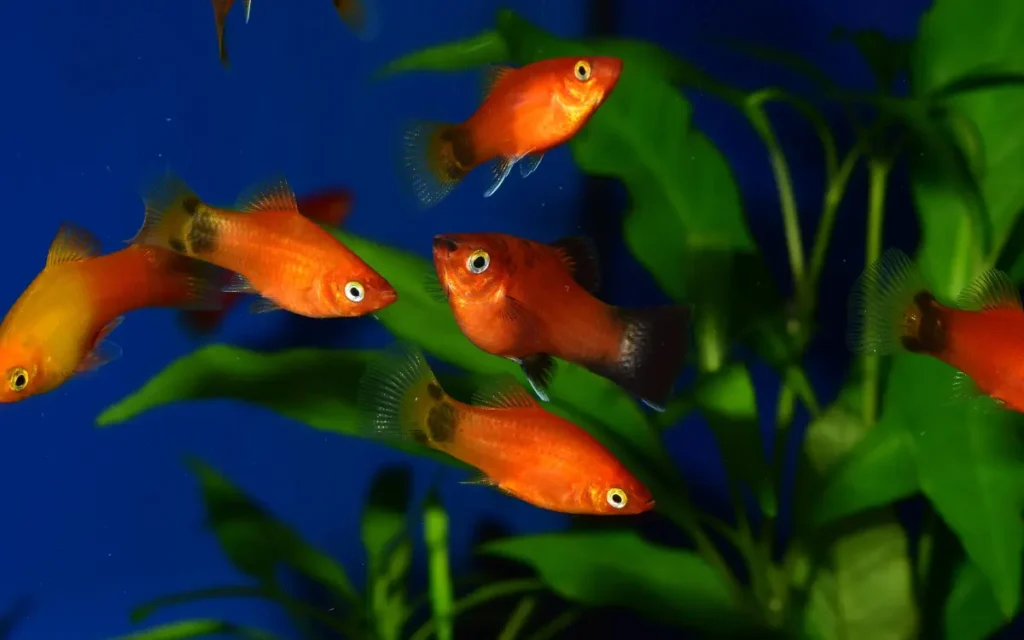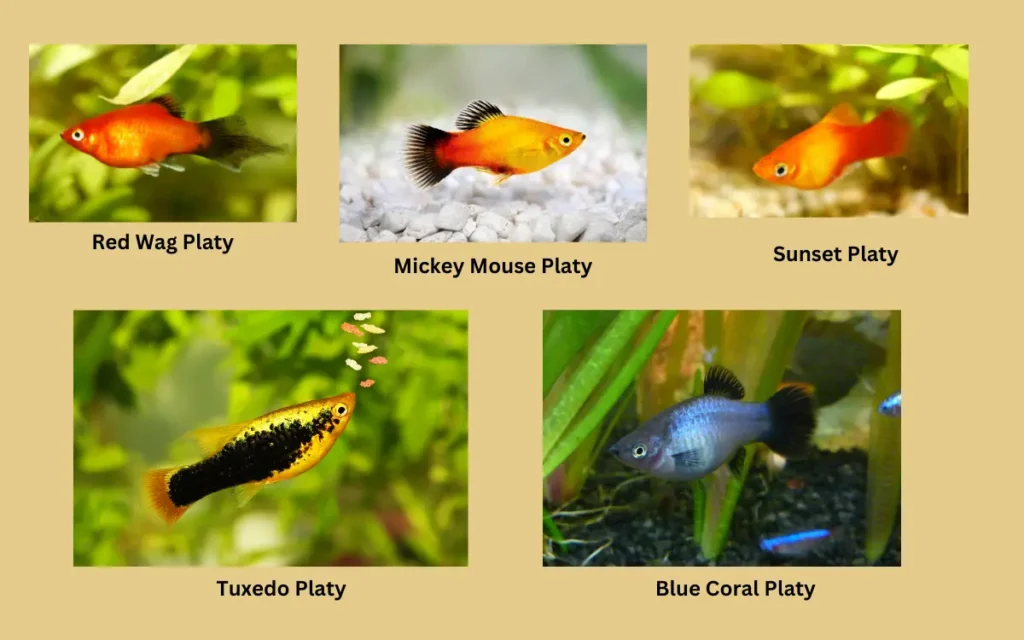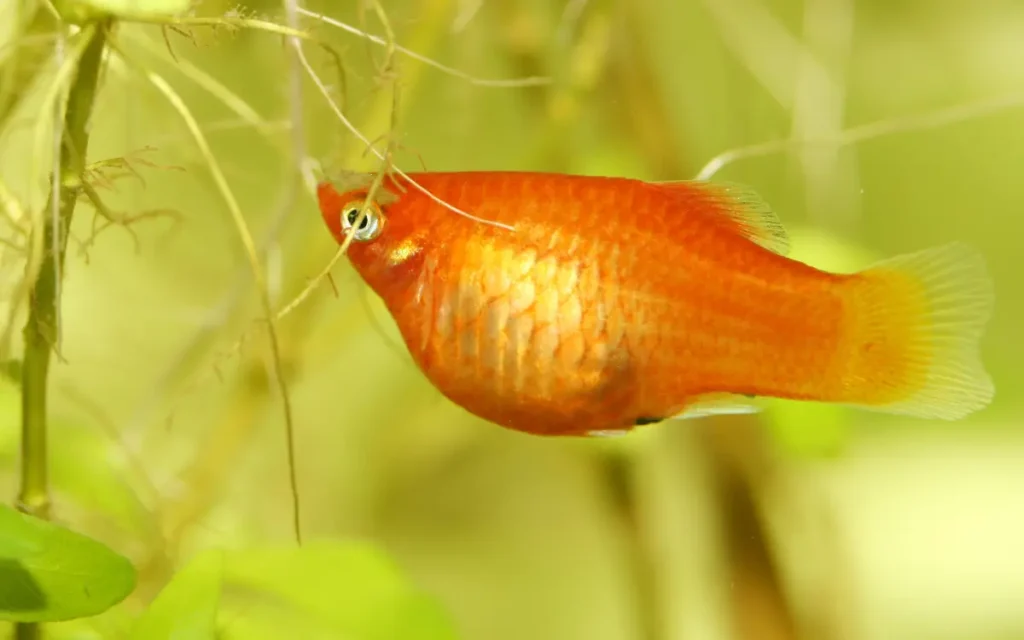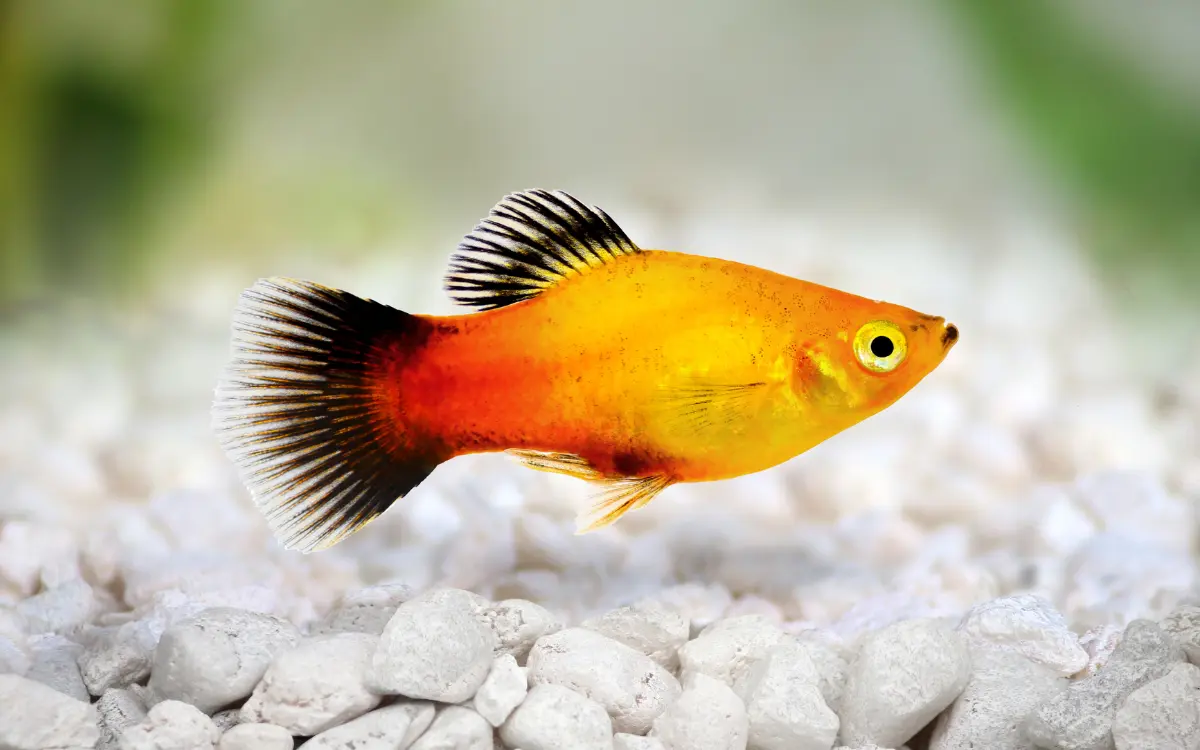Platies fish, scientifically known as Xiphophorus maculatus, are among the most popular and beginner-friendly freshwater fish in the aquarium hobby. originating from central america they are very adaptive for different types of water conditions.
Today we will see how to care and what type of platies species you can choose for your freshwater aquarium setup.
Platies Profile fish

| Attribute | Description |
| Family | Poeciliidae |
| Aggressiveness | Peaceful |
| Minimum Tank Size | 10 gallons |
| Life Span | 3-5 years |
| Diet | Omnivorous (flakes, pellets, live and frozen foods) |
| Size | 2-3 inches |
| Compatibility | Good with other peaceful community fish (tetras, guppies, mollies, corydoras) |
| Temperament | Friendly, active, and social |
Species and Types of Platies Fish
Platies, belonging to the genus Xiphophorus, are small, vibrant freshwater fish commonly found in the aquarium hobby. Two primary species are widely recognized: the Southern Platyfish (Xiphophorus maculatus) and the Variatus Platy (Xiphophorus variatus). These species have been selectively bred to produce a dazzling array of colors, patterns, and fin shapes, making them a favorite among aquarists.
Common Types of Platies Fish

Red Wag Platy: Characterized by its bright red body and contrasting black fins, the Red Wag Platy is one of the most popular and visually striking varieties.
Mickey Mouse Platy: Known for the unique black pattern near its tail, resembling the silhouette of Mickey Mouse, this platy variety is especially popular among children.
Sunset Platy: With a beautiful gradient of colors ranging from yellow to deep orange, the Sunset Platy brings a warm, tropical feel to any tank.
Tuxedo Platy: Featuring a combination of dark and light colors, the Tuxedo Platy typically has a black rear half and a brightly colored front half.
Blue Coral Platy: This variety showcases stunning shades of blue and turquoise, adding a cool, serene aesthetic to the aquarium.
Rare Platies Fish Varieties
Neon Gold Calico Platy: This rare variety boasts a brilliant gold color with splashes of black and orange, creating a striking calico pattern.
Parrot Platy: With its vibrant red and orange coloration and a unique pattern resembling a parrot’s plumage, this platy is a rare and beautiful find.
Hi Fin Platy: Known for its elongated dorsal fin, the Hi Fin Platy is a distinctive variety that stands out due to its unusual fin shape and diverse coloration.
Pintail Platy: This variety is rare and notable for its tail fin, which narrows to a point, giving it a unique appearance compared to other platies.
Tiger Platy: Featuring bold black stripes against a bright orange or red background, the Tiger Platy resembles the pattern of a tiger and is a rare and sought-after variety among enthusiasts.
Best Platies Fish Tank for Beginners
Setting up an aquarium for platies can be an enjoyable and rewarding experience, especially for beginners. Here is a detailed guide on the ideal setup for a platies fish tank:
Tank Size
Minimum Size: 10 gallons
Recommended Size: 20 gallons or larger to provide ample swimming space and accommodate more fish.
Tank Setup
Substrate:
Use fine gravel or sand as the substrate. Platies are not particular about the substrate, but a natural look can enhance their colors.
Filtration:
- Choose a reliable filter with adjustable flow. Platies prefer moderate water flow.
- A sponge filter is a good option for beginners due to its gentle filtration and ease of maintenance.
Heater:
- Platies thrive in temperatures between 70-82°F (21-28°C).
- Use a heater to maintain a stable temperature, especially in cooler climates.
Lighting:
- Moderate lighting is sufficient. LED lights are energy-efficient and enhance the colors of the fish and plants.
Decorations and Plants:
- Include plenty of hiding spots and plants. Live plants such as java fern, anubias, and hornwort are excellent choices.
- Add decorations like rocks, driftwood, and caves to create a stimulating environment.
Water Parameters:
- pH: 7.0-8.2
- Hardness: 10-28 dGH
- Regular water changes (25% weekly) help maintain water quality.
Stocking
Platies:
- Start with a small group of 5-6 platies. They are social fish and thrive in groups.
- Mix different color varieties for a visually appealing tank.
Compatible Tank Mates:
- Tetras, guppies, mollies, corydoras, and snails make good tank mates.
- Avoid aggressive fish that might nip at the platies’ fins.
Feeding
- Platies are omnivores. Feed them a balanced diet consisting of high-quality flake food, pellets, and occasional treats like brine shrimp, bloodworms, and blanched vegetables (e.g., spinach or zucchini).
- Feed small amounts 2-3 times a day, ensuring they consume all food within a few minutes to avoid overfeeding and water pollution.
Maintenance
- Regularly check water parameters with a test kit.
- Perform weekly water changes (25%) to keep the water clean.
- Clean the filter monthly, but avoid replacing all filter media at once to preserve beneficial bacteria.
Additional Tips
- Cycling the Tank: Before adding fish, ensure the tank is cycled. This means establishing beneficial bacteria that break down harmful ammonia and nitrites.
- Observation: Regularly observe your platies for any signs of illness, such as lethargy, unusual swimming patterns, or spots on their bodies. Early detection and treatment are key to maintaining a healthy tank.
How to Breed Platies Fish

Breeding platies is a relatively straightforward process due to their livebearing nature and hardy disposition. Here is a comprehensive guide to help you successfully breed platies in your aquarium:
Preparing the Tank
Breeding Tank:
- Set up a separate breeding tank (10-20 gallons) to protect the fry from being eaten by adult fish.
- Equip the tank with a sponge filter to provide gentle filtration without harming the fry.
Water Conditions:
- Maintain the temperature between 75-80°F (24-27°C).
- Keep the pH between 7.0-8.2 and the water hardness between 10-28 dGH.
- Perform regular water changes to keep the water clean and stable.
Plants and Hiding Spots:
- Add plenty of live plants like java moss, hornwort, and guppy grass to provide hiding spots for the fry.
- Use decorations and breeding traps to offer additional shelter.
Selecting Breeding Pairs
Healthy Fish:
- Choose healthy, vibrant platies for breeding. Look for active fish with no signs of disease or deformities.
- Select a ratio of one male to two or three females to reduce stress on the females.
Identifying Sex:
- Males are typically smaller, with a modified anal fin called a gonopodium.
- Females are larger and more rounded, especially when gravid (pregnant).
Breeding Process
Introducing the Pair:
- Place the selected breeding pair(s) in the breeding tank.
- Ensure the tank has plenty of hiding spots to reduce stress.
Mating:
- Males will chase and court the females. Successful mating occurs when the male’s gonopodium makes contact with the female.
- Females can store sperm and give birth multiple times from a single mating.
Gestation:
- The gestation period for platies is approximately 24-30 days.
- As the female’s belly grows, you may notice a dark gravid spot near her anal fin.
Birth and Care of Fry
Separating Fry:
- Once the female is close to giving birth, move her to a breeding box or net within the tank to protect the fry from being eaten.
- After giving birth, remove the female to prevent her from eating the fry.
Feeding Fry:
- Feed the fry high-quality food like crushed flakes, baby brine shrimp, and micro worms.
- Offer small, frequent meals to ensure they receive adequate nutrition.
Raising Fry:
- Keep the tank clean and maintain stable water conditions.
- Perform regular water changes and monitor the fry’s growth and health.
Growth and Development:
- As the fry grows, you can gradually introduce them to the main tank, ensuring they are large enough not to be eaten by adult fish.
Additional Tips
- Frequent Observation: Regularly check the breeding tank for signs of stress or illness in the breeding pair and fry.
- Record Keeping: Keep a breeding log to track mating dates, gestation periods, and the number of fry produced.
- Genetic Diversity: To maintain genetic health, avoid breeding closely related fish.
Platies fish Feeding tables.
| Type of Food | Description | Frequency | Quantity |
| High-Quality Flake Food | Balanced diet formulated for tropical fish. | Daily | Small pinch that can be consumed in 2-3 minutes. |
| Pellets | Sinking or floating pellets designed for tropical fish. | Daily | Quantity that can be consumed in 2-3 minutes. |
| Live Foods | Brine shrimp, daphnia, bloodworms, and micro worms. Provides excellent protein and stimulates natural hunting behavior. | 2-3 times a week | Small amount per feeding. |
| Frozen Foods | Frozen versions of live foods like brine shrimp and bloodworms. Convenient and nutritious. | 2-3 times a week | Small amount per feeding. |
| Vegetables | Blanched vegetables like spinach, zucchini, and peas. Adds fiber and essential nutrients to their diet. | 1-2 times a week | Small pieces that can be consumed in a few minutes. |
| Freeze-Dried Foods | Freeze-dried brine shrimp, bloodworms, and daphnia. Nutritious and easy to store, but ensure they are fully soaked before feeding to prevent digestive issues. | 1-2 times a week | Small amount per feeding. |
FAQs
Q: How many plates should be kept together?
A: Platies are social fish that thrive in groups. It is recommended to keep at least 5-6 platies together to promote natural behavior and reduce stress.
Q: What fish can live with platies?
A: Platies are peaceful and can live with other non-aggressive community fish such as tetras, guppies, mollies, corydoras, and snails. Avoid keeping them with aggressive or fin-nipping species.
Q: Are platies a beginner fish?
A: Yes, platies are an excellent choice for beginners. They are hardy, adaptable to various water conditions, and relatively easy to care for, making them ideal for new aquarists.
Q: What is the lifespan of a platyfish?
A: Platies typically live for 3-5 years with proper care, including a balanced diet, clean water, and a stable environment.
Q: Do platy fish sleep?
A: Yes, platies do sleep. They rest by becoming less active and finding a quiet spot in the tank, usually during the night when the lights are off.
Q: Which pet fish live the longest?
A: Koi and goldfish are among the longest-living pet fish, with lifespans that can exceed 20 years with proper care. Some cichlids and catfish species also have long lifespans.
Q: Can platies breed with guppies?
A: No, platies and guppies cannot breed with each other. They are different species and do not produce viable offspring together.
Q: Is my platy pregnant?
A: If your female platy has a noticeably larger and rounder belly, especially with a dark gravid spot near her anal fin, she is likely pregnant. Platies give birth to live young, so you may see fry in the tank soon.
Q: Do platies eat their fry?
A: Yes, adult platies may eat their fry. To increase the survival rate of the fry, provide plenty of hiding spots with plants and decorations or use a breeding box to separate the fry from the adults.

